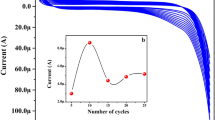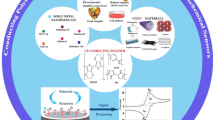Abstract
A rapid voltammetric method is described for the determination of the organophosphorus pesticide paraoxon-ethyl (PEL). A glassy carbon electrode (GCE) was modified with a composite consisting of a poly(N-isopropylacrylamide)-chitosan microgel with incorporated palladium nanoparticles. The microgel was characterized by FE-SEM, EDX, XPS, FTIR, XRD, and EIS. The modified GCE is shown to enable direct electro-reductive determination of PEL by using differential pulse voltammetry. The method works in pH 7 solution and in the 0.01 μM to 1.3 mM PEL concentration range. At a typical working potential of −0.66 V (vs. Ag/AgCl) (at 50 mV/s), the detection limit is as low as 0.7 nM, and the electrochemical sensitivity is 1.60 μA μM−1 cm−2. Intriguingly, the modified GCE displays good recovery when applied to bok choy and water samples.

Schematic of an electrochemical method for determination of paraoxon ethyl (PEL) in bok choy extract and water by using poly(N-isopropyl acrylamide)-chitosan microgel decorated with palladium nanoparticle-modified glassy carbon electrodes (PdNPs/PNIPAM-CT microgel/GCE).








Similar content being viewed by others
References
Khan A, Othman MBH, Chang BP, Akil HM (2015) Preparation, physicochemical and stability studies of chitosan-PNIPAM based responsive microgels under various pH and temperature conditions. Iran Polym J 24:317–328
Stuart MAC, Huck WT, Genzer J, Müller M, Ober C, Stamm M, Sukhorukov GB, Szleifer I, Tsukruk VV, Urban M, Winnik F (2010) Emerging applications of stimuli-responsive polymer materials. Nat Mater 9:101–113
Hoshino Y, Ohashi RC, Miura Y (2014) Rational design of synthetic nanoparticles with a large reversible shift of acid dissociation constants: proton imprinting in stimuli responsive nanogel particles. Adv Mater 26:3718–3723
Zhuang J, Gordon MR, Ventura J, Li L, Thayumanavan S (2013) Multi-stimuli responsive macromolecules and their assemblies. Chem Soc Rev 42:7421–7435
Borges AC, Bourban PE, Pioletti DP, Månson JA (2010) Curing kinetics and mechanical properties of a composite hydrogel for the replacement of the nucleus pulposus. Compos Sci Technol 70:1847–1853
Echeverria C, Soares P, Robalo A, Pereira L, Novo CM, Ferreira I, Borges JP (2015) One-pot synthesis of dual-stimuli responsive hybrid PNIPAAm-chitosan microgels. Materials Design 86:745–751
Schild HG (1992) Poly (N-isopropylacrylamide): experiment, theory and application. Prog Polym Sci 17:163–249
Yin Z, Zhang J, Jiang LP, Zhu JJ (2009) Thermosensitive behavior of poly (N-isopropylacrylamide) and release of incorporated hemoglobin. J Phys Chem C 113:16104–16109
Lu Y, Ballauff M (2011) Thermosensitive core–shell microgels: from colloidal model systems to nanoreactors. Prog Polym Sci 36:767–792
Baghayeri M, Veisi H, Farhadi S, Beitollahi H, Maleki B (2018) Ag nanoparticles decorated Fe3O4/chitosan nanocomposite: synthesis, characterization and application toward electrochemical sensing of hydrogen peroxide. J Iran Chem Soc 15:1015–1022
Patil AS, Gadad AP, Hiremath RD, Dandagi PM (2018) Exploration of the effect of chitosan and crosslinking agent concentration on the properties of dual responsive chitosan-g-poly (N-Isopropylacrylamide) co-polymeric particles. J Polym Environ 26:596–606
Prabaharan M, Mano JF (2006) Stimuli-responsive hydrogels based on polysaccharides incorporated with thermo-responsive polymers as novel biomaterials. Macromol Biosci 6:991–1008
Liu W, Huang Y, Liu H, Hu Y (2007) Composite structure of temperature sensitive chitosan microgel and anomalous behavior in alcohol solutions. J Colloid Interface Sci 313:117–121
Hernández P, Lucero-Acuña A, Gutiérrez-Valenzuela CA, Moreno R, Esquivel R (2017) Systematic evaluation of pH and thermoresponsive poly (n-isopropylacrylamide-chitosan-fluorescein) microgel. E-Polymers 17:399–408
Marković BM, Maksin DD, Mojović ZD, Vuković ZM, Nastasović AB, Jovanović DM (2017) Electrochemical behavior of palladium modified amino-functionalized macroporous copolymer. J Electroanal Chem 786:94–101
Jaiswal MK, Banerjee R, Pradhan P, Bahadur D (2010) Thermal behavior of magnetically modalized poly (N-isopropylacrylamide)-chitosan based nanohydrogel. Colloids Surf B 81:185–194
Liu F, Huang L, Duan X, Li YY, Hu JQ, Li BH, Lu JA (2018) Facile method to prepare noble metal nanoparticles modified self-assembly (SAM) electrode. J Exp Nanosci 13:1–10
Nitzan A, Ratner MA (2003) Electron transport in molecular wire junctions. Science 300:1384–1389
Rehman S, Khan AR, Shah A, Badshah A, Siddiq M (2017) Preparation and characterization of poly (N-isoproylacrylamide-co-dimethylaminoethyl methacrylate) microgels and their composites of gold nanoparticles. Colloids Surf A Physicochem Eng Asp 520:826–833
Thomas V, Namdeo M, Murali Mohan Y, Bajpai SK, Bajpai M (2007) Review on polymer, hydrogel and microgel metal nanocomposites: a facile nanotechnological approach. Journal of macromolecular science part a. Pure Appl Chem 45:107–119
Hondred JA, Breger JC, Alves NJ, Trammell SA, Walper SA, Medintz IL, Claussen JC (2018) Printed graphene electrochemical biosensors fabricated by inkjet maskless lithography for rapid and sensitive detection of organophosphates. ACS Appl Mater Interfaces 10:11125–11134
Pimenta GG, de Queiroz ME, Victor RP, Noronha LM, Neves AA, Oliveira AFD, Heleno FF (2017) DLLME-GC/ECD method for the residual analysis of parathion-methyl and its application in the study of the UV-Photodegradation process. J Braz Chem Soc 28:2045–2053
Chambers JE, Oppenheimer SF (2004) Organophosphates, serine esterase inhibition, and modeling of organophosphate toxicity. Toxicol Sci 77:185–187
Lee DH, Lind PM, Jacobs DR Jr, Salihovic S, van Bavel B, Lind L (2016) Association between background exposure to organochlorine pesticides and the risk of cognitive impairment: a prospective study that accounts for weight change. Environ Int 89:179–184
Karasali H, Maragou N (2016) “Pesticides and herbicides: Types of pesticide”. 319–325
Karthik R, Vinoth Kumar J, Chen SM, Kokulnathan T, Yang HY, Muthuraj V (2018) Design of Novel Ytterbium Molybdate Nano-flakes Anchored Carbon Nanofibers: a challenging sustainable catalyst for the detection and degradation of assassination weapon (Paraoxon-ethyl). ACS Sustain Chem Eng 6:8615–8630
Wei M, Feng S (2017) Amperometric determination of organophosphate pesticides using a acetylcholinesterase based biosensor made from nitrogen-doped porous carbon deposited on a boron-doped diamond electrode. Microchim Acta 184:3461–3468
Ye C, Zhong X, Wang MQ, Chai Y, Yuan R (2016) Cyclovoltammetric acetylcholinesterase activity assay after inhibition and subsequent reactivation by using a glassy carbon electrode modified with palladium nanorods composited with functionalized C60 fullerene. Microchim Acta 183:2403–2409
Ullah I, Khan K, Sohail M, Ullah K, Ullah A, Shaheen S (2017) Synthesis, structural characterization and catalytic application of citrate-stabilized monometallic and bimetallic palladium@ copper nanoparticles in microbial anti-activities. Int J Nanomedicine 12:8735–8747
Zhang C, Govindaraju S, Giribabu K, Huh YS, Yun K (2017) AgNWs-PANI nanocomposite based electrochemical sensor for detection of 4-nitrophenol. Sensors Actuators B Chem 252:616–623
Chang MM, Ginjom IR, Ng SM (2017) Single-shot ‘turn-off’optical probe for rapid detection of paraoxon-ethyl pesticide on vegetable utilising fluorescence carbon dots. Sensors Actuators B Chem 242:1050–1056
Author information
Authors and Affiliations
Corresponding author
Ethics declarations
The author(s) declare that they have no competing interests.
Additional information
Publisher’s note
Springer Nature remains neutral with regard to jurisdictional claims in published maps and institutional affiliations.
Electronic supplementary material
ESM 1
(DOCX 2.50 mb)
Rights and permissions
About this article
Cite this article
Mutharani, B., Ranganathan, P., Chen, SM. et al. Enzyme-free electrochemical detection of nanomolar levels of the organophosphorus pesticide paraoxon-ethyl by using a poly(N-isopropyl acrylamide)-chitosan microgel decorated with palladium nanoparticles. Microchim Acta 186, 167 (2019). https://doi.org/10.1007/s00604-018-3206-7
Received:
Accepted:
Published:
DOI: https://doi.org/10.1007/s00604-018-3206-7




